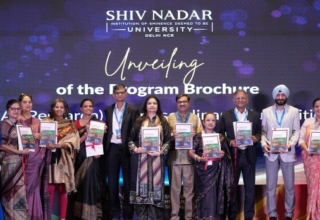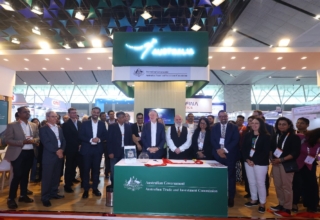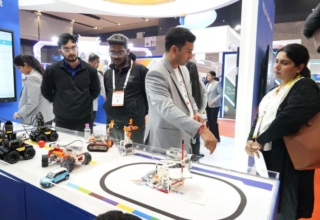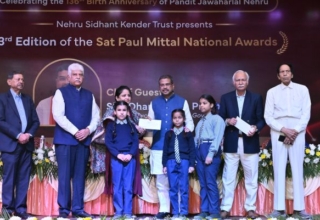
There is no probability that online mode of education will completely replace traditional classroom teaching methods, because in this way the psycho-social and emotional aspect would be eliminated from the learning process which is undesirable, instead a combination of technology and tradition would suffice the demands in future.
Dr Nitesh Dhawan & Komal Kapoor discuss
Deprivation opens the door for new destinations. Teaching and learning are one of those spheres which have seemed to turn around obstacles into opportunities.

The exacerbating conditions under extended lockdown period have pushed the educational institutions to explore various options for compensating the loss of their academic session. The increasing number of webinars and virtual conferences clearly indicate towards the adaptiveness of academic organisations in a challenging scenario. Admitting the importance of both real classrooms teaching and online mode of learning, a concept of blended learning has emerged which is a style of education in which students learn via electronic and online media as well as traditional face-to-face learning.
Recently, we got an opportunity to be a part of online faculty development programme on the very relevant topic pertaining to transition towards blended learning which was altogether a different learning experience. It not only added to our repository of knowledge and skills but also enriched our vision of imparting education with the application of technology as a facilitator and making it more interesting for learners as well. The unprecedented covid-19 crisis has compelled us to unfold new avenues, and with propagation of digital India campaign, we have been able to find answers to many questions around us. The technological platforms offer learning management system (LMS) and content management system (CMS) in the form of Moodle (modular object oriented dynamic learning) and Google respectively. The moodle as LMS has significant features that comprises of preparing a course content, assignment, quiz, workshop, resource, discussion forum, assessment of students etc. The gnomio site on moodle, screencasting through softwares like screen-O-matic, apowersoft, OBS and website creation for content management on Google are other effective tools to aid blended form of teaching and learning. There are important tools for formative and summative assessment of learners for evaluating their performance. The issues of copyright could be taken care of with the appropriate use of creative commons licence policy.
The intended objective of teaching according to revised bloom’s taxonomy is to assist learners to remember – understand – apply- analyse- evaluate and to create new ideas Technology certainly has all those features that can guide both educators as well as learners to move to the next level of experiential learning.
Government initiatives in e-learning during COVID-19 outbreak
The Department of School Education in the Government of India and all States and Union Territories have launched three e-learning platforms on SHAGUN Online Junction. These are –
NROER (National Repository of Open Educational Resources) where students get the opportunity to visit e-libraries, e-books, e-courses and also get a chance to participate in online education-based events. It has 2779 documents, 1345 interactive, 1664 audios, 2586 images and 6153 videos in different languages.
DIKSHA is a National Digital Infrastructure for Teachers portal to provide learning material to teachers as well as students by scanning the QR code available in the book,
E-Pathshala is a web portal for students of class I-XII where the learning material in the form of e-books, audios and videos is made available by NCERT.
Government of India has also started Swayam-Prabha a collection of 32 DTH channels which run 24X7 for the students from class I-XII, undergraduates and postgraduate students.
Bottlenecks in the road to Online Education
There are several factors which are responsible for widening the digital gap in India such as geographical location, lack of awareness regarding usage and usability of online resources, lack of infrastructure, inadequate access to fundamental resources, imbalances in quality of resources in different regions, demographic features like age, socio-economic status, educational status etc. of the recipients. During the lockdown period the existence of above factors in encumbering online education remains the same, and along with this there are certain other factors which emerged as annoying hindrances in the list of bottlenecks.
The primary and secondary school teachers in the absence of any proper training in conduction of online classes display helplessness in this hour and this inability is not confined to rural areas only. Even teachers in urban areas having little computer literacy and unbeknownst to online teaching strategies grapple the same situation. Only the elitist schools having access to full-time high-speed network are able to use Zoom, Skype, Google Classroom and other such interfaces to provide online education to their students and their students also have the means to access the same facilities at home so teaching-learning in online mode can go easy. There are students belonging to normal schools or government schools in cities which don’t have fast speed internet services, face the problem of connectivity so online mode has not proven much beneficial for them. Some teachers are not so techno savvy hence delivering an online lecture or taking an online class is something which is new for them and the teachers also need time to adjust with the online education system.

There is no probability that online mode of education will completely replace traditional classroom teaching methods, because in this way the psycho-social and emotional aspect would be eliminated from the learning process which is undesirable, instead a combination of technology and tradition would suffice the demands in future. The students, parents and teachers should be made aware of the uses of technology in education so that they develop a positive attitude towards online education and accept the value of online learning as equal to classroom learning. Secondly, parental sensitization is also important so that they can supervise their children when they use internet services and also see that their children do not excessively become dependent on online resources because overuse can cause physical distress as well as leads to social and emotional alienation among children. Let blended education become an integral part of our educational system so that in future, in the wake of any unexpected and unforeseen situation the education shouldn’t come to a halt.


Dr Nitesh Dhawan is a public servant and author &
Komal Kapoor an Assistant Professor at S.D.P.G College, Deoria, U.P
____________________________________________________________________










